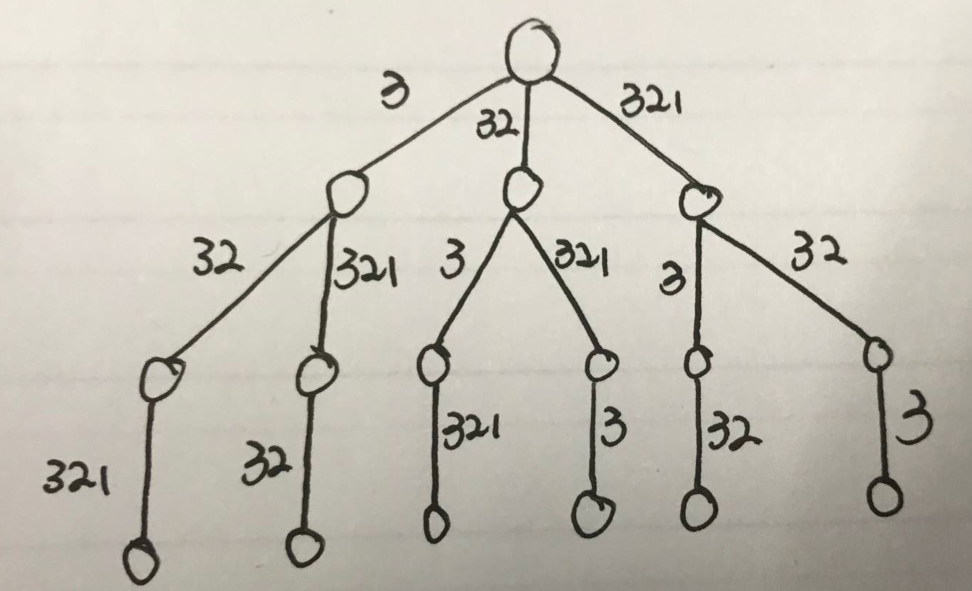题目链接:https://www.nowcoder.com/practice/8fecd3f8ba334add803bf2a06af1b993?tpId=13&tqId=11185&tPage=2&rp=2&ru=%2Fta%2Fcoding-interviews&qru=%2Fta%2Fcoding-interviews%2Fquestion-ranking
题目描述:

析:这道题的解空间其实是一个“排列树”,比如输入是{3 , 32 , 321}时,排列树如下:

所以可以考虑使用回朔法解决。再次回顾一下回朔法的思想:从根节点开始一层一层向下扩展,当扩展到“非扩展节点”时则回溯到上一层,在进行“约束条件”(路径合理性)和“上界条件”(路径最优性,实现剪枝功能)的判断,如果满足则从该节点的另一条路径继续向下,否则继续回溯,就是这样一个递归算法;详细解释可以参考:https://www.cnblogs.com/zf-blog/p/8973051.html
代码如下:
#include<iostream> #include<string> #include<vector> #include<cmath> using namespace std; long long min = 0; //最小数 int n = 0; //排列树的深度(从0开始) long long current = 0; //到达某一节点时的值 vector<long long> x; //最优解中数组元素的排列 long long m_1(vector<long long> sub, vector<long long> numbers) //为了计算到达某一节点时的值 { int count = 0; for (int i = 0; i < numbers.size(); i++) { long long tmp = numbers[i]; bool flag = false; //不包含 for (int j = 0; j < sub.size(); j++) { if (tmp == sub[j]) { flag = true; break; } } if (flag == false) { if (numbers[i] == 0) count++; else { while (numbers[i] % 10) { count++; numbers[i] /= 10; } } } } return pow(10 , count); } void Backtrack(int t) //回溯算法 { if (t >= n) { current = 0; string current_str = ""; for (int i = 0; i < n; i++) { string tmp = to_string(x[i]); current_str.append(tmp); } current = atoll(¤t_str.at(0)); if (current < min) min = current; return; } for (int i = t; i < n; i++) { swap(x[t], x[i]); vector<long long> tmp; for (int j = 0; j <= t; j++) { tmp.push_back(x[j]); } long long m_2 = m_1(tmp, x); string current_str = ""; for (int m = 0; m < tmp.size(); m++) { string tmp_str = to_string(tmp[m]); current_str.append(tmp_str); } current = atoll(¤t_str.at(0)) * m_2; if (current < min) { Backtrack(t + 1); } swap(x[t], x[i]); } } string PrintMinNumber(vector<long long> numbers) { n = numbers.size(); string min_str = ""; for (int i = 0; i < n; i++) { x.push_back(numbers[i]); string tmp = to_string(numbers[i]); min_str.append(tmp); } min = atoll(&min_str.at(0)); Backtrack(0); string output = to_string(min); return output; } int main(int argc, char *argv[]) { vector<long long> numbers(3); long long a[3] = { 12 , 33 , 4 }; for (int i = 0; i < 3; i++) { numbers[i] = a[i]; } string output = PrintMinNumber(numbers); cout << output << endl; system("pause"); return 0; }
PS:该算法在VS上验证OK,在牛客网自带的编译器中会出错,属于编译问题;